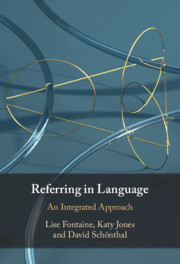Book contents
- Referring in Language
- Referring in Language
- Copyright page
- Contents
- Figures
- Tables
- Acknowledgements
- Part I The Nature of Referring and Referring Expressions
- Part II Typical Reference
- Part III Atypical Reference
- 7 Referring in Non-collaborative Contexts
- 8 Indefinite Expressions for Referring Definitely
- 9 Child’s Play
- 10 Reference and Metonymy
- 11 Epilogue
- References
- Index
10 - Reference and Metonymy
from Part III - Atypical Reference
Published online by Cambridge University Press: 22 June 2023
- Referring in Language
- Referring in Language
- Copyright page
- Contents
- Figures
- Tables
- Acknowledgements
- Part I The Nature of Referring and Referring Expressions
- Part II Typical Reference
- Part III Atypical Reference
- 7 Referring in Non-collaborative Contexts
- 8 Indefinite Expressions for Referring Definitely
- 9 Child’s Play
- 10 Reference and Metonymy
- 11 Epilogue
- References
- Index
Summary
This chapter explores referential metonymy as an atypical use of reference. After reviewing relevant literature on referential metonymy, we consider the extent to which it is inherently atypical. Using examples of metonymy from medical discourse contexts, including nurse handover discourse and medical students self-reflections, we situate metonymy as a type of reference, that is, metonymic reference, and examine features which establish its use as atypical reference. We show that typical or atypical uses of metonymic reference depend on a variety of factors. While metonymic reference is essential in some contexts for safe and efficient reference, we also show that in some cases its use can signal stigmatisation of patients and/or difficulties of medical professions in maintaining moral. In these cases, referential choice becomes especially significant.
- Type
- Chapter
- Information
- Referring in LanguageAn Integrated Approach, pp. 197 - 216Publisher: Cambridge University PressPrint publication year: 2023

